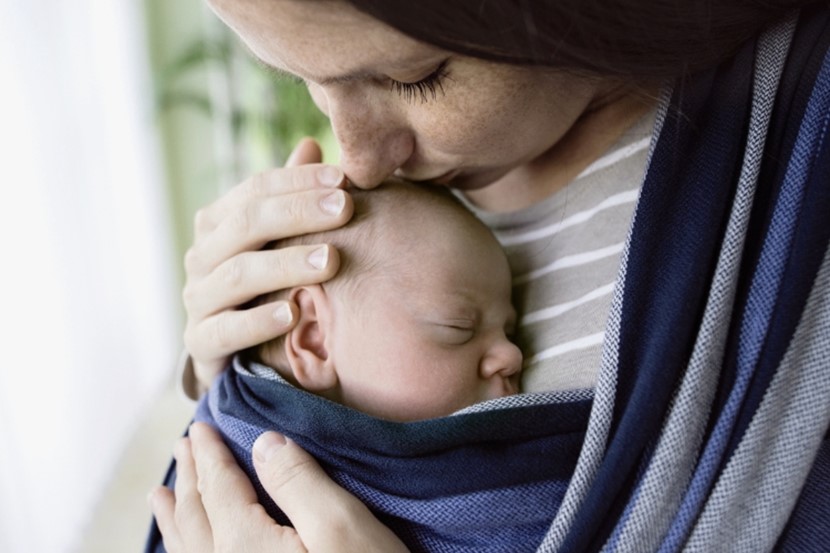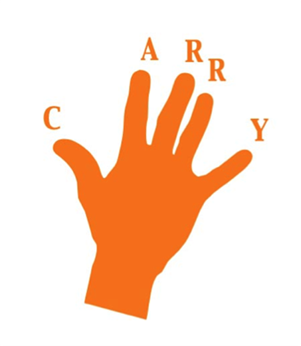Babywearing safety tips

"CARRY" Rule of Hand
To make safe Babywearing practices easy to remember, we have developed the 'Rule of Hand'. Each finger represents a different babywearing safety tip. By simply learning these five tips, reinforced each time you glance at your hand, you will learn to trust your instincts and enjoy the closeness of your babe. As a parent, you are ultimately responsible for the safety of your child, but these tips you will give you confidence about wearing your baby.
C-A-R-R-Y:
CAREFUL. If you wouldn't do an activity whilst pregnant, don't do it while wearing your baby. Like being pregnant, babywearing can tilt your centre of gravity and not allow you to see your feet much. Avoid climbing ladders, horse riding, parasailing, and any other risky sport that could lead to a fall. Unlike being inside your womb where the baby is protected somewhat, the carried baby does not have inbuilt protection surrounding them. Be mindful of what your baby can reach. Babywearing in the kitchen? Watch the hot pot on the stove or the kitchen knife when you turn to grab something else.
AIRFLOW. You should always be able to easily see your baby's face without opening the fabric. Ensure that your baby's chin is not pressed against his/her chest to allow easy breathing. To check, simply slip two fingers under baby's chin to ensure that breathing is not hindered which could otherwise lead to 'positional asphyxia'. This can occur in any device, including some prams and car seats that allow the head to flop forward thereby blocking small airways, so be vigilant.
RIDE HIGH. Keep the baby high and tight against your chest, not low on your hips. This will also afford you a good line of sight to monitor your baby's needs and wellbeing. A sling or carrier should mimic holding baby in your arms, or in the instance of back carry, like a piggy back. You would find it tiring carrying baby in your arms lower than your belly button, likewise a sling that carries your baby low will quickly prove sore on your shoulders and back.
RIGHT FIT. Make sure that you read your sling/ carrier's instruction booklet and/or watch the videos (if available) so you can ensure the carrier is the right fit for your body shape and the age/weight of your baby. When trying a new carry position, test it with a doll or teddy the first few times, with your partner to spot check you. Back carry positions are recommended to learn while kneeling in the middle of your bed.
YOUR INSTINCT. You are the parent, trust your instinct. Try to mimic with the carrier/sling, the way you would naturally hold your baby with your arms. You should always be able to make eye contact with your baby. This will allow you to determine whether baby is safe, happy and content. A cursory glance will allow you to quickly assess if their chin is up and that they are comfortable. Using the back carry position? Invest in a Rear View Mirror for peace of mind.
Like all practices, it is important to understand how to use the tools of the trade correctly to ensure safe and effective use. Babes in Arms is committed to ensuring that parents and caregivers are well informed about Babywearing Safety so that all caregivers are able to confidently enjoy the benefits of baby wearing. As the only Australian and New Zealand distributor specializing in a range of slings and carriers, Babes in Arms only imports products which comply with stringent US standards and from manufacturers who have load tested all products and have adequate product liability insurance in place. Although the incident rate with slings/ carriers is very low in comparison with prams, car seats or walkers, always make sure you choose a brand that does have these protections in place to safe guard your family.
Knowledge is the key to confidence. Remember to research the sling or carrier you would like to use with your baby; purchase it from a reputable stockist and seek out help when you need it - the Babywearing Community is very supportive and willing to share helpful tips.
Following the 5 CARRY simple safety steps, Babywearing will provide you with a settled and contented baby and the freedom that pram pushers wish they had!
This article (abridged) was produced by Babes in Arms and is republished on OHbaby! with permission. It is intended to provide general information in summary form on the safe use of baby carriers. It does not replace any instructions provided by the manufacturer. Babes in Arms and OHbaby! do not accept liability for any death or injury, or damage to property resulting from reliance on this article.

